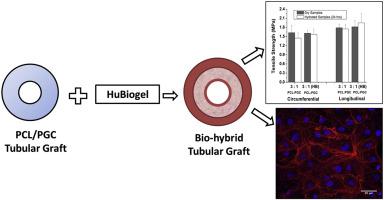当前位置:
X-MOL 学术
›
Mater. Today Chem.
›
论文详情
Our official English website, www.x-mol.net, welcomes your feedback! (Note: you will need to create a separate account there.)
HuBiogel incorporated fibro-porous hybrid nanomatrix graft for vascular tissue interfaces
Materials Today Chemistry ( IF 7.3 ) Pub Date : 2020-09-01 , DOI: 10.1016/j.mtchem.2020.100323 H N Patel 1 , Y K Vohra 2 , R Singh 3, 4 , V Thomas 1, 2, 5
Materials Today Chemistry ( IF 7.3 ) Pub Date : 2020-09-01 , DOI: 10.1016/j.mtchem.2020.100323 H N Patel 1 , Y K Vohra 2 , R Singh 3, 4 , V Thomas 1, 2, 5
Affiliation

|
Native extracellular matrix (ECM) possesses the biochemical cues to promote cell survival. However, decellularized, the ECM loses its cell supporting mechanical integrity. We report, here, a novel biohybrid vascular graft of polycaprolactone (PCL), poliglecaprone (PGC) incorporated with human biomatrix as functional materials for vascular tissue interfacing by electrospinning, thus harnessing the biochemical cues from the ECM and the mechanical integrity of the polymer blends. The fabricated fibro-porous tubular small diameter graft (i.d. = 4 mm) from polymer blend was coated with a cocktail of collagenous matrix derived from human placenta called HuBiogel™. The compositional, morphological, and mechanical properties of graft were measured and compared with a non-coated tubular PCL/PGC graft using Fourier Transform infrared spectroscopy (FTIR), x-ray photoelectron spectroscopy (XPS), and scanning electron microscopy (SEM). BCA assay was used to calculate the protein content and coating-uniformity throughout the hybrid graft. Mechanical properties such as tensile strength (1.6 MPa), Young's modulus (2.4 MPa), burst pressure (>1900 mmHg), and suture retention strength (2.3 N) of hybrid graft were found to be comparable to native blood vessels. Protein coating has improved the hydrophilicity and the biocompatibility (cell viability and cell-attachment) enhanced with human umbilical vein endothelial cells (HUVECs) seeded in vitro onto the lumen layer of the graft over two weeks. The overall results promise this new biohybrid graft to be a potential candidate for vascular tissue interface and regeneration.
中文翻译:

HuBiogel 将纤维多孔混合纳米基质移植物用于血管组织界面
天然细胞外基质 (ECM) 具有促进细胞存活的生化线索。然而,去细胞后,ECM 失去了支持机械完整性的细胞。我们在这里报告了一种新型的聚己内酯 (PCL)、聚己内酯 (PGC) 的生物混合血管移植物,它与人类生物基质结合作为通过静电纺丝连接血管组织的功能材料,从而利用来自 ECM 的生化线索和聚合物混合物的机械完整性. 由聚合物混合物制成的纤维多孔管状小直径移植物(id = 4 mm)涂有源自人胎盘的胶原基质混合物,称为 HuBiogel™。使用傅立叶变换红外光谱 (FTIR) 测量了接枝物的组成、形态和机械性能,并与无涂层管状 PCL/PGC 接枝物进行了比较,X 射线光电子能谱 (XPS) 和扫描电子显微镜 (SEM)。BCA 测定用于计算整个杂交移植物中的蛋白质含量和涂层均匀性。发现混合移植物的拉伸强度 (1.6 MPa)、杨氏模量 (2.4 MPa)、爆裂压力 (> 1900 mmHg) 和缝合线保留强度 (2.3 N) 等机械性能与天然血管相当。蛋白质涂层改善了亲水性和生物相容性(细胞活力和细胞附着),在两周内在体外接种到移植物的腔层上的人脐静脉内皮细胞 (HUVEC) 增强了。总体结果表明,这种新的生物杂交移植物将成为血管组织界面和再生的潜在候选者。BCA 测定用于计算整个杂交移植物中的蛋白质含量和涂层均匀性。发现混合移植物的拉伸强度 (1.6 MPa)、杨氏模量 (2.4 MPa)、爆裂压力 (> 1900 mmHg) 和缝合线保留强度 (2.3 N) 等机械性能与天然血管相当。蛋白质涂层改善了亲水性和生物相容性(细胞活力和细胞附着),在两周内在体外接种到移植物的腔层上的人脐静脉内皮细胞 (HUVEC) 增强了。总体结果表明,这种新的生物杂交移植物将成为血管组织界面和再生的潜在候选者。BCA 测定用于计算整个杂交移植物中的蛋白质含量和涂层均匀性。发现混合移植物的拉伸强度 (1.6 MPa)、杨氏模量 (2.4 MPa)、爆裂压力 (> 1900 mmHg) 和缝合线保留强度 (2.3 N) 等机械性能与天然血管相当。蛋白质涂层改善了亲水性和生物相容性(细胞活力和细胞附着),在两周内在体外接种到移植物的腔层上的人脐静脉内皮细胞 (HUVEC) 增强了。总体结果表明,这种新的生物杂交移植物将成为血管组织界面和再生的潜在候选者。发现混合移植物的杨氏模量 (2.4 MPa)、爆裂压力 (>1900 mmHg) 和缝合线保留强度 (2.3 N) 与天然血管相当。蛋白质涂层改善了亲水性和生物相容性(细胞活力和细胞附着),在两周内在体外接种到移植物的腔层上的人脐静脉内皮细胞 (HUVEC) 增强了。总体结果表明,这种新的生物杂交移植物将成为血管组织界面和再生的潜在候选者。发现混合移植物的杨氏模量 (2.4 MPa)、爆裂压力 (>1900 mmHg) 和缝合线保留强度 (2.3 N) 与天然血管相当。蛋白质涂层改善了亲水性和生物相容性(细胞活力和细胞附着),在两周内在体外接种到移植物的腔层上的人脐静脉内皮细胞 (HUVEC) 增强了。总体结果表明,这种新的生物杂交移植物将成为血管组织界面和再生的潜在候选者。蛋白质涂层改善了亲水性和生物相容性(细胞活力和细胞附着),在两周内在体外接种到移植物的腔层上的人脐静脉内皮细胞 (HUVEC) 增强了。总体结果表明,这种新的生物杂交移植物将成为血管组织界面和再生的潜在候选者。蛋白质涂层改善了亲水性和生物相容性(细胞活力和细胞附着),在两周内在体外接种到移植物的腔层上的人脐静脉内皮细胞 (HUVEC) 增强了。总体结果表明,这种新的生物杂交移植物将成为血管组织界面和再生的潜在候选者。
更新日期:2020-09-01
中文翻译:

HuBiogel 将纤维多孔混合纳米基质移植物用于血管组织界面
天然细胞外基质 (ECM) 具有促进细胞存活的生化线索。然而,去细胞后,ECM 失去了支持机械完整性的细胞。我们在这里报告了一种新型的聚己内酯 (PCL)、聚己内酯 (PGC) 的生物混合血管移植物,它与人类生物基质结合作为通过静电纺丝连接血管组织的功能材料,从而利用来自 ECM 的生化线索和聚合物混合物的机械完整性. 由聚合物混合物制成的纤维多孔管状小直径移植物(id = 4 mm)涂有源自人胎盘的胶原基质混合物,称为 HuBiogel™。使用傅立叶变换红外光谱 (FTIR) 测量了接枝物的组成、形态和机械性能,并与无涂层管状 PCL/PGC 接枝物进行了比较,X 射线光电子能谱 (XPS) 和扫描电子显微镜 (SEM)。BCA 测定用于计算整个杂交移植物中的蛋白质含量和涂层均匀性。发现混合移植物的拉伸强度 (1.6 MPa)、杨氏模量 (2.4 MPa)、爆裂压力 (> 1900 mmHg) 和缝合线保留强度 (2.3 N) 等机械性能与天然血管相当。蛋白质涂层改善了亲水性和生物相容性(细胞活力和细胞附着),在两周内在体外接种到移植物的腔层上的人脐静脉内皮细胞 (HUVEC) 增强了。总体结果表明,这种新的生物杂交移植物将成为血管组织界面和再生的潜在候选者。BCA 测定用于计算整个杂交移植物中的蛋白质含量和涂层均匀性。发现混合移植物的拉伸强度 (1.6 MPa)、杨氏模量 (2.4 MPa)、爆裂压力 (> 1900 mmHg) 和缝合线保留强度 (2.3 N) 等机械性能与天然血管相当。蛋白质涂层改善了亲水性和生物相容性(细胞活力和细胞附着),在两周内在体外接种到移植物的腔层上的人脐静脉内皮细胞 (HUVEC) 增强了。总体结果表明,这种新的生物杂交移植物将成为血管组织界面和再生的潜在候选者。BCA 测定用于计算整个杂交移植物中的蛋白质含量和涂层均匀性。发现混合移植物的拉伸强度 (1.6 MPa)、杨氏模量 (2.4 MPa)、爆裂压力 (> 1900 mmHg) 和缝合线保留强度 (2.3 N) 等机械性能与天然血管相当。蛋白质涂层改善了亲水性和生物相容性(细胞活力和细胞附着),在两周内在体外接种到移植物的腔层上的人脐静脉内皮细胞 (HUVEC) 增强了。总体结果表明,这种新的生物杂交移植物将成为血管组织界面和再生的潜在候选者。发现混合移植物的杨氏模量 (2.4 MPa)、爆裂压力 (>1900 mmHg) 和缝合线保留强度 (2.3 N) 与天然血管相当。蛋白质涂层改善了亲水性和生物相容性(细胞活力和细胞附着),在两周内在体外接种到移植物的腔层上的人脐静脉内皮细胞 (HUVEC) 增强了。总体结果表明,这种新的生物杂交移植物将成为血管组织界面和再生的潜在候选者。发现混合移植物的杨氏模量 (2.4 MPa)、爆裂压力 (>1900 mmHg) 和缝合线保留强度 (2.3 N) 与天然血管相当。蛋白质涂层改善了亲水性和生物相容性(细胞活力和细胞附着),在两周内在体外接种到移植物的腔层上的人脐静脉内皮细胞 (HUVEC) 增强了。总体结果表明,这种新的生物杂交移植物将成为血管组织界面和再生的潜在候选者。蛋白质涂层改善了亲水性和生物相容性(细胞活力和细胞附着),在两周内在体外接种到移植物的腔层上的人脐静脉内皮细胞 (HUVEC) 增强了。总体结果表明,这种新的生物杂交移植物将成为血管组织界面和再生的潜在候选者。蛋白质涂层改善了亲水性和生物相容性(细胞活力和细胞附着),在两周内在体外接种到移植物的腔层上的人脐静脉内皮细胞 (HUVEC) 增强了。总体结果表明,这种新的生物杂交移植物将成为血管组织界面和再生的潜在候选者。



























 京公网安备 11010802027423号
京公网安备 11010802027423号